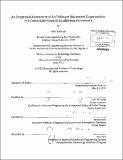An integrated assessment of air pollutant abatement opportunities in a computable general equilibrium framework
Author(s)
Waugh, C. (Caleb Joseph)
DownloadFull printable version (23.05Mb)
Alternative title
Integrated assessment of air pollution abatement opportunities in a computable general equilibrium framework
Other Contributors
Massachusetts Institute of Technology. Technology and Policy Program.
Advisor
John M. Reilly.
Terms of use
Metadata
Show full item recordAbstract
Air pollution and anthropogenic greenhouse gas emission reduction policies are desirable to reduce smog, tropospheric concentrations of ozone precursors, acid rain, and other adverse effects on human health, the environment, and the economy. While reduction of both air pollution and greenhouse gas emissions is often attained through economic instruments such as taxes, caps, and other regulation, emission controls in both developed and developing countries often achieves reduction through policies that target air pollution and greenhouse gases separately. However, because the emissions of both air pollution and greenhouse gases are often intrinsically linked to the same sources, any attempt to design policies to optimally achieve desired reduction goals must consider the complex socioeconomic interactions that produce both kinds of emissions as they collectively react to regulatory constraints. Integrated assessment models have often been used as tools to inform policy design by representing the interactions between technology, economics, policy, and the environment within a self-contained framework. Many contemporary integrated assessment models consider emissions of greenhouse gases while others also consider air pollution emissions. While greenhouse gas reduction opportunities are often represented endogenously in the models through the availability of backstop technologies such as carbon capture and storage or by shifts away from carbon intensive to less carbon intensive production, representation of air pollutant reduction has largely been represented within integrated assessment models exogenously based on empirically observed trends. By treating air pollution reduction opportunities exogenously, such models are unable to represent many key considerations important to policy design including the true economic impact of air pollutant reduction policy, the impact such policies may have on the market penetration of backstop energy production technologies, and the ancillary co-benefits of air pollution policy on greenhouse gas emission reduction. To overcome current limitations imposed by exogenous representation of air pollution abatement, I develop a new method for representing air pollutant abatement opportunities endogenously within an integrated assessment model designed using a computable general equilibrium (CGE) framework. CGE models are often used to simulate macroeconomic activity based on microeconomic theory and are well suited for emission policy analysis because of their ability to represent the interactions between multiple economic regions and sectors, to connect emission sources to economic activity, and to accommodate a large degree of technological detail not captured by other macroeconomic models. Using this new method, I demonstrate how the parameters needed to represent the abatement opportunities are derived from engineering data on specific abatement technologies available within each economic sector and for distinct fuel types as air pollution is largely generated through the combustion of hydrocarbon fuels. With both the methodology and parameterization established, I represent sulfur dioxide and nitrous oxide abatement opportunities in the MIT Emissions Prediction and Policy Analysis (EPPA) model and compare model results with previous representations of air quality pollutant reduction methodologies based on exogenous trends. An example of how the model predicts co-benefits for C0₂ reduction and policy costs in China is then presented. Overall, the new model demonstrates the ability to fully capture important effects relevant to policy design not captured in integrated assessment models where air pollution abatement is exogenously represented.
Description
Thesis (S.M. in Technology and Policy)-- Massachusetts Institute of Technology, Engineering Systems Division, Technology and Policy Program, 2012. Cataloged from PDF version of thesis. Includes bibliographical references (p. 116-121).
Date issued
2012Department
Massachusetts Institute of Technology. Engineering Systems Division; Technology and Policy ProgramPublisher
Massachusetts Institute of Technology
Keywords
Engineering Systems Division., Technology and Policy Program.